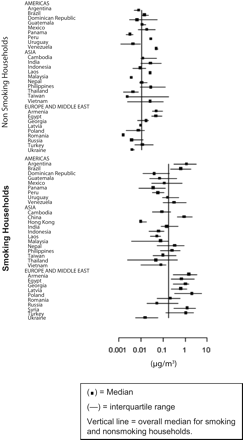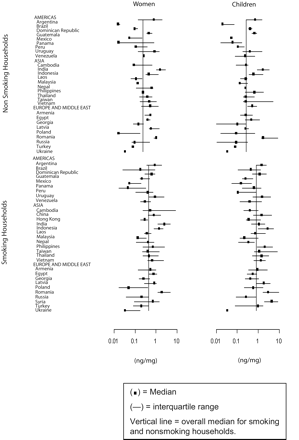Secondhand smoke exposure among women and children: evidence from 31 countries
- PMID: 18309121
- PMCID: PMC2376995
- DOI: 10.2105/AJPH.2007.126631
Secondhand smoke exposure among women and children: evidence from 31 countries
Abstract
Objectives: We sought to describe the range of exposure to secondhand smoke (SHS) among women and children living with smokers around the world and generate locally relevant data to motivate the development of tobacco control policies and interventions in developing countries.
Methods: In 2006, we conducted a cross-sectional exposure survey to measure air nicotine concentrations in households and hair nicotine concentrations among nonsmoking women and children in convenience samples of 40 households in 31 countries.
Results: Median air nicotine concentration was 17 times higher in households with smokers (0.18 mug/m(3)) compared with households without smokers (0.01 mug/m(3)). Air nicotine and hair nicotine concentrations in women and children increased with the number of smokers in the household. The dose-response relationship was steeper among children. Air nicotine concentrations increased an estimated 12.9 times (95% confidence interval=9.4, 17.6) in households allowing smoking inside compared with those prohibiting smoking inside.
Conclusions: Our results indicate that women and children living with smokers are at increased risk of premature death and disease from exposure to SHS. Interventions to protect women and children from household SHS need to be strengthened.
Figures


References
-
- US Department of Health and Human Services. The Health Consequences of Involuntary Exposure to Tobacco Smoke: A Report of the Surgeon General. Washington, DC: US Dept of Health and Human Services; 2006.
-
- Halterman JS, Fagnano M, Conn KM, Szilagyi PG. Do parents of urban children with persistent asthma ban smoking in their homes and cars? Ambul Pediatr. 2006;6:115–119. - PubMed
-
- Cobanoglu N, Kiper N, Dilber E, et al. Environmental tobacco smoke exposure and respiratory morbidity in children. Inhal Toxicol. 2007;19:779–785. - PubMed
Publication types
MeSH terms
Substances
Grants and funding
LinkOut - more resources
Full Text Sources
Medical

